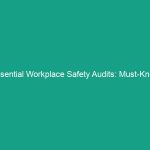Introduction
Good morning team! Today, we are going to discuss an extremely important topic that affects our daily operations and overall Workplace Safety: Essential Guidelines to Prevent Underground Utility Strikes in Your Projects. This topic is crucial because underground utility strikes can lead to severe injuries, property damage, and costly delays in project timelines. Understanding how to prevent these incidents is vital for our Safety and the success of our projects.
Understanding Essential Guidelines to Prevent Underground Utility Strikes
Underground utility strikes occur when excavation activities unintentionally damage underground utilities such as gas, water, sewer, or electrical lines. These incidents can have devastating Effects, including injuries to workers, disruption of services, and financial losses for the company. It’s essential to understand that these strikes can happen if proper Precautions are not taken, and they are not just the responsibility of one individual but require teamwork and communication.
Many workers might assume that utility lines are marked accurately or that they can estimate where they are located. However, relying on assumptions can lead to dangerous situations. Always remember: when in doubt, dig safe!
Key Hazards, Risks, and Safety Considerations
Understanding the risks associated with underground utility strikes is the first step in preventing them. Here are some of the key Hazards and risks:
- Physical Injury: Striking a utility line can lead to serious injuries, including Burns, electrocution, or even fatalities.
- Service Disruption: Damage to utility lines can disrupt services to homes and businesses, leading to dissatisfaction and financial loss.
- Environmental Impact: Leaks from damaged gas or oil lines can cause significant environmental harm.
Ignoring safety protocols related to underground utilities can lead to severe real-world consequences, including legal ramifications and reputational damage to our organization. Remember that safety is not just a priority; it is a value we must uphold at all times.
Best Practices, Procedures, & Actionable Advice
Here are essential guidelines to prevent underground utility strikes:
1. Conduct a Thorough Site Assessment
Before starting any excavation work, conduct a comprehensive site assessment. This includes:
- Reviewing utility maps and plans.
- Contacting local utility companies for information about underground services.
- Identifying any potential hazards in the area.
2. Locate and Mark Utilities
Once you have gathered the necessary information, mark the location of all utilities clearly on the job site. Use color-coded flags and paint to indicate:
- Red for electric
- Yellow for gas
- Blue for water
- Green for sewer
- Orange for telecommunications
3. Use Proper Digging Techniques
When excavation begins, always follow these Best Practices:
- Use hand tools when working within 18 inches of marked utilities.
- Maintain a safe distance from known utility lines.
- Listen to team members’ observations and concerns while digging.
4. Implement a Safety Plan
Have a clear safety plan in place that includes:
- Emergency contact information.
- Procedures for reporting utility strikes.
- Regular safety meetings to address concerns and discuss incidents.
5. Continuous Training and Awareness
Ongoing education is vital. Regularly train employees on:
- Identifying utility lines.
- Safe excavation practices.
- Emergency response Procedures in case of a utility strike.
For instance, a case study from our previous project involved a minor utility strike due to a lack of communication about marked lines. The incident led to service disruptions and a review of our safety protocols, highlighting the need for continual training and awareness.
Regulations, Standards, and Compliance
Compliance with safety Regulations is not optional; it is mandatory. Familiarize yourself with relevant Standards such as:
- OSHA regulations regarding Excavation Safety.
- Local building codes and utility regulations.
- Company-specific safety protocols.
Adhering to these regulations not only protects you but also ensures that the project runs smoothly and efficiently.
Employee Engagement & Discussion
Now that we have covered the essential guidelines, let’s open the floor for discussion. Consider these questions:
- What safety challenges have you encountered related to underground utilities?
- How can we improve our current practices to ensure greater safety?
- Do you have any suggestions for additional training topics related to this issue?
Conclusion & Key Takeaways
In conclusion, preventing underground utility strikes is a shared responsibility that requires diligence, communication, and education. Remember these key takeaways:
- Always conduct thorough site assessments and mark utilities accurately.
- Use safe digging techniques and maintain a culture of safety.
- Stay compliant with all relevant regulations and standards.
By prioritizing these practices, we can ensure a safer work Environment for everyone. Thank you for your commitment to safety and for your attention today. Let’s work together to make our projects safe and successful!


